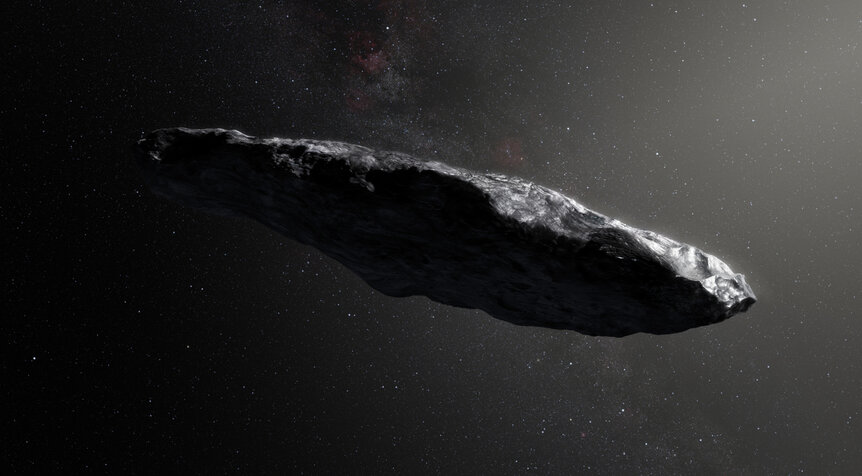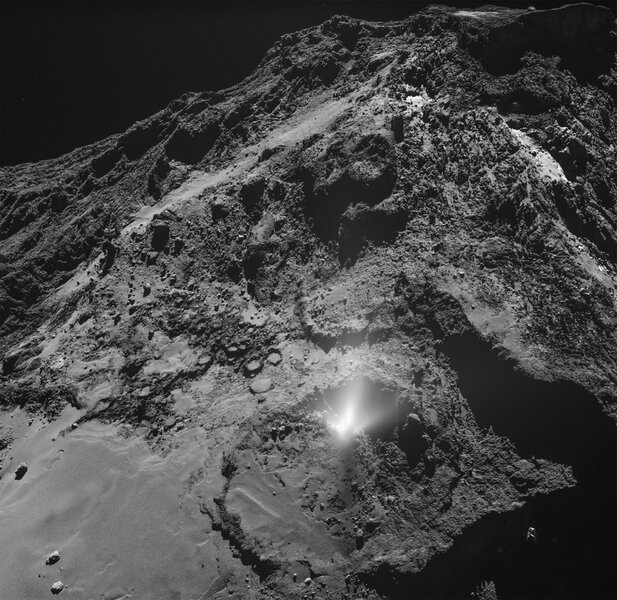Create a free profile to get unlimited access to exclusive videos, sweepstakes, and more!
Is 'Oumuamua an interstellar spaceship? I'm still going with 'no.'
Is 'Oumuamua, the weird object from interstellar space that barreled through our solar system late last year, an alien spaceship?
Spoiler: No.
Well, almost certainly no. I can't say unequivocally that it's not, but I can say that I would bet a lot of money against it.
[tl;dr for impatient people: Some of the behavior of 'Oumuamua fits with a ship, but more importantly some important behaviors do not. My conclusion is that it's something natural. It's weird — after all, it's been traveling through the galaxy for thousands of years at least — but natural.]
The reason I have to say this at all is because of a new research paper just made public analyzing just that possibility. The paper — which, I'll note, has not yet been peer-reviewed — looks at some of the odd behaviors of the object and concludes that they fit the pattern of it being an interstellar spacecraft, and more specifically, a light sail.
The paper is interesting, but to me it's not convincing, and by that I mean I don't think the evidence presented even really makes the case it might be a spaceship. To see why I need to give you some background.
In late October of 2017, astronomers discovered an object on a very strange orbit. It was moving hyperbolically, which means so rapidly that it could escape the solar system, never to return. And it had quite a bit of extra speed, too: about 25 kilometers per second, which pretty much meant it had to come from interstellar space, too. That is, from another star.
Some folks — not astronomers — speculated it might be a spaceship. I downplayed that even in my first post about it!
It was eventually given the name 'Oumuamua (Hawaiian for "very first scout," and the leading apostrophe is an 'okina, like a glottal stop), and to be fair it had a lot of weird behaviors. For one, it was at first assumed to be a comet — a rocky body with lots of embedded ice. But it got close enough to the Sun to turn surface ice into a gas, which should dislodge enough dust to reflect a lot of sunlight, making the object brighter. However, no such emission was seen.
It also got brighter and dimmer on a fairly regular 7-8-hour cycle, implying it's elongated and tumbling end-over-end, like a stick thrown overhand. That cycle implied it has to be really elongated, like 6-10 times longer than it is wide! That's very weird*.
And then there's the very weirdest thing. As it was leaving the solar system, it was accelerating (or, more accurately, not decelerating as much as you'd expect due to the Sun's gravity acting on it). It was as if some other force besides gravity were in play. The obvious (to astronomers) idea is that it really is like a comet. As ice turns to gas and expands, it applies a force to the object. However, again, no such emission was detected. So that's a bit of a mystery.
Starting with that last idea, the new paper looks into the possibility that the pressure of sunlight was acting on the visitor. Photons have no mass, but they can exert a pressure; radiation pressure is well understood using the physics of General Relativity. This pressure is pretty small, but it can be significant for objects of low mass but large area. It's a pressure, after all, so if you're big the force on you is stronger, and if you don't have much mass that force accelerates you more.
Applying a few assumptions, the authors conclude that the acceleration 'Oumuamua underwent makes sense if, instead of being a big space cigar, it's more like a flattened sheet. A thin one, just a millimeter thick and perhaps 30 meters across.
This sounds suspiciously like a solar or light sail. This is a way to accelerate a spaceship to high speed without a rocket: Instead, you attach your cargo to a very large but very lightweight reflective sail, and let the pressure of sunlight push on it. This sounds silly, but in fact is a very well studied idea. In fact, The Planetary Society plans on launching a test sail sometime in the near future.
So. Is 'Oumuamua a spaceship?
The authors stop short of saying that it is in so many words, though they imply it pretty heavily. As others have noted, the lead author, Avi Loeb, works on a project investigating sending a solar sail to nearby stars, so it makes sense he'd think of this. But do their ideas hold water? (or photons?)
Well…
I have a lot of issues with the idea. For one thing, the periodic brightness change is hard to explain with a sail. Unless it's out of control, and tumbling… but that means it wouldn't work as a sail, and the basis for their whole idea is wrong anyway.
Also, just because we didn't see any comet-like emission from 'Oumuamua doesn't mean there wasn't any. Traveling through interstellar space for thousands of years means it was exposed to galactic cosmic rays, which could change the surface chemistry and the way it emits material. Typically it's the dust that gets bright, so if it emitted gas instead of dust that would make it harder to see. And we didn't see it until it was well on its way out of the solar system when it was faint, so again we could've missed it.
The authors reference a paper that says that if it did vent material, the rotation period would change, since that would likely apply a torque to it. No such change was seen, so, following the logic, it didn't vent anything. But that paper isn't peer-reviewed yet either. And if, say, the venting were done at the center of mass the rotation wouldn't be affected anyway. That's being picky, but the point is lack of evidence is not evidence of lacking.
To be fair, I'll add that we know how bright 'Oumuamua was and how far away it was when it passed. That means that if we know how reflective it was we can estimate its size — something darker would have to be bigger, and something shinier could be smaller. It turns out that if 'Oumuamua is 100% reflective, like a mirror (or a solar sail), it would be about 50 meters across… which is about the size the authors estimate. So that's neat. Not convincing, but at least it doesn't contradict the assumption.
But that's also a problem. A big one… or really a little one. Why build a solar sail that small? The bigger it is the more efficient it is, and the faster it would go. If you're trying to get from Point A to interstellar Point B, you'll have a need for speed.
And speaking of which, related to that, the speed bugs me. 25 kps is fast, but not interstellar travel fast. That's really important! The whole point of a solar sail is that it has low acceleration but accelerates for a long time, and gets to very high speed. Thousands or even tens of thousands of kilometers per second are achievable, and that's what you want for travel between stars! 25 kps is a crawl compared to that, and doesn't make sense for a ship. The authors do a hand-wavy dismissal of this, saying maybe it was non-operation space debris, and tossed out as jetsam. That strikes me as special pleading, and that's a no-no in these kinds of arguments. The relatively slow speed and small size of 'Oumuamua for a ship are important characteristics and shouldn't simply be dismissed.
There are other issues as well, but I think you see the point: Sure, some of the behaviors of 'Oumuamua align with it being a ship, but that doesn't make it one. And some of its behaviors most certainly do not, and when you're making an argument like this those are the ones you need to pay particular attention to.
As you'd imagine, the paper made quite a splash, with several media picking it up fairly uncritically. Conversely, some folks have dismissed the spaceship idea out of hand, but again, to be fair I think it's worth at least looking into. We have the math and physics to make some reasonable guesses… and look, 'Oumuamua is damn odd. Sure, start with the assumption it's natural, because "aliens" is a last resort. But taking a moment to poke at it and think about it isn't a bad idea.
This all reminds me of Tabby's Star, which is also very weird. No astronomer I know thinks that's aliens, but looking at it to make sure isn't a bad idea. It's low effort and has a ridiculously high payoff if true. And even if false we learn more about the star, which is what astronomy is all about.
In the case of 'Oumuamua, as with Tabby's Star, I'm not seeing aliens. I'm seeing the Universe — a vast, complex laboratory with a huge amount of raw material and lots of room for subtle variations that can, given enough time, come up with some pretty strange stuff around the edges of what you usually see.
And you know what? That's still really, really cool.
*This elongation is more than for any solar system object ever seen… but remember, it's implied from the brightness variations. We can't actually see 'Oumuamua as more than a dot. It's important to know that variations of reflectivity on its surface can amplify that brightness change; Saturn's moon Iapetus has one hemisphere that's 10 times brighter than the other, which would be enough to make you think it's elongated and tumbling, 'Oumuamua-like, if we didn't know any better.




























